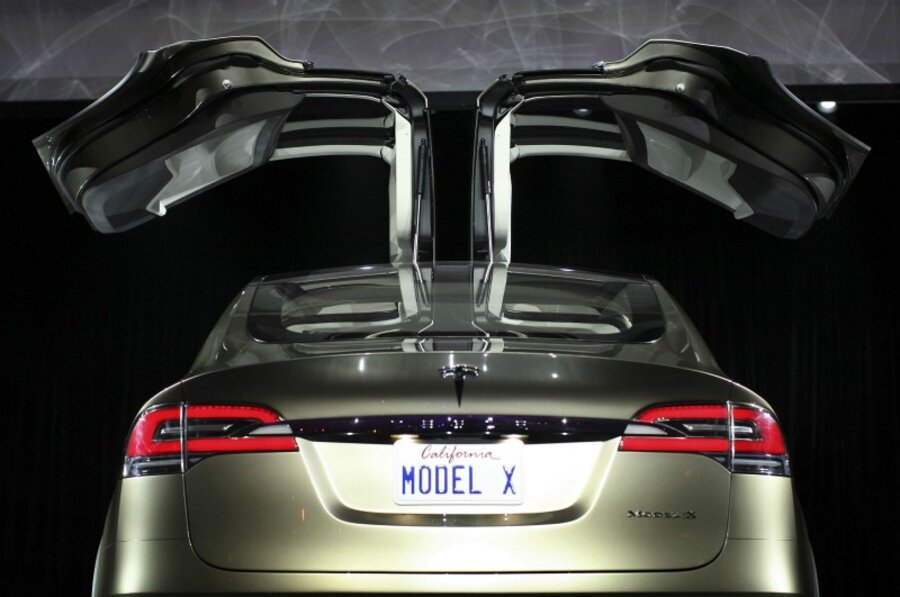Tesla SUV with wings or not, we should kill the electric car
Loading...
| Berkeley, Calif.
California passed a ruling on Jan. 27 requiring that 15 percent of new cars sold in the state meet a strict emissions standard of zero to near-zero emissions by 2015. Many environmental groups are praising the decision, which will require Californians to buy more electric, hybrid, and hydrogen vehicles. I was once enthusiastic about these cars, too.
About 20 years ago, CNN showcased an alternative-fuel vehicle that I built with my own hands. I drove back and forth in front of the camera, smiling from behind the wheel of my two-seater electric and natural gas hybrid. I thought it was an especially beneficial solution to our environmental challenges. I was wrong.
What counts as an alternative-energy vehicle and what doesn’t is hardly a straightforward reckoning. For instance, is an electric car a true alternative if its drivetrain is ultimately powered by coal, nuclear power, and lithium strip mines rather than petroleum? When the Royal Society of Chemistry ran the numbers, it found that fully adopting electric cars in Britain would only reduce the country’s CO2 emissions by about 2 percent.
Electric vehicles don’t eliminate the negative side effects of vehicular travel. They simply move the problems elsewhere – often to contexts where they become more opaque and difficult to address. When we start to exchange one set of side effects for another, the exchange rates become confusing. This opens a space for PR firms, news pundits, environmentalists, and others to step in and define the terms of exchange to their liking.
For instance, electric vehicle manufacturers claim that customers can fill up for ten cents per kilowatt-hour, which they say works out to pennies on the mile. But if buyers intend to drive their electric car beyond the length of the extension cord from their garage, they won’t be able to take advantage of that cheap electricity. They’ll have to rely on a battery – a battery they can only recharge a finite number of times before it must be replaced, at considerable expense.
The battery-construction step, not the “fuel” step, is the expensive part of driving an electric vehicle. Advanced batteries cost so much to fabricate that the ten-cent-per-kilowatt-hour “fuel” cost to charge them becomes negligible.
Even though electric vehicles are moving to cheaper batteries, the costs of exhuming their required minerals extends far beyond simple dollars and cents. It takes a lot of fossil fuel to craft a battery. An analysis by the National Academies concludes that the environmental damage stemming from grid-dependent hybrids and electric vehicles will be greater than that of traditional gasoline-driven cars until at least 2030, even when assuming favorable technological advances. At current battery-production levels, mining activities already draw fire from local environmental and human rights organizations that are on the ground to witness the worst of the atrocities.
Even if mining companies clean up their operations (which at least will require much stricter international regulations) and engineers increase battery storage capacity (which they will, very slowly) there is still a bigger problem looming on the horizon: Alternative-fuel vehicles stand to define and spread patterns of “sustainable living” that cannot be easily sustained without cars.
Cars enable people to spread out into patterns of suburban development, which induces ecological consequences beyond the side effects of the vehicle itself. Even the most efficient hybrid or electric cars can’t resolve the larger ecological impacts of sprawl. In fact, their green badges of honor might even help them fuel it. For a time, this may not pose a problem, but eventually it will. Sprawl has positive and negative effects on Americans, but its intensification is clearly at odds with the long-term ideals of the environmental movement.
The suburban architecture of fully disengaged homes and megastores, connected by wide streets and highways, has prompted a mass deployment of energy resources that would have been unthinkable just a generation before its formation. It is from within the suburban addiction that Americans grew to understand extreme energy waste as perfectly normal.
This life isn’t just wasteful. It’s expensive, too. Relatively efficient city dwellers end up subsidizing new suburban road construction, power lines, sewers, and water mains – at a cost of about $13,426 per suburbanite, according to a recent study.
Upon closer consideration, shifting from gasoline to electric vehicles starts to appear synonymous with switching a smoking habit from cloves to menthols. Even with all of the hype surrounding hybrid and electric vehicles, these machines are becoming somewhat of a cliché in some circles. Hybrid and electric vehicles may offer partial solutions within certain contexts, but those contexts are looking to be frightfully limited.
It isn’t acceptable for doctors to promote menthol cigarettes. Should environmentally minded people promote alternatively fueled automobiles? Some community groups are saying “No.” They’re showing how concerned citizens are better achieving their environmental objectives by supporting more durable options such as walkable neighborhoods, bicycling infrastructure, carpooling, traffic calming (incorporating physical features to slow or reduce traffic – wider sidewalks, roundabouts, etc.), and comfortable public transit.
These transportation strategies have a proven track record of success in cities across the globe. Beyond their greening impact, they can also make cities more vibrant, affordable, and pleasant places to live. Green strategies that improve people’s lived experience, rather than emptying their wallets, have the potential to catch on.
Now that’s genuinely energizing.
Ozzie Zehner is the author of “Green Illusions: The Dirty Secrets of Clean Energy and the Future of Environmentalism.” He is a visiting scholar at the University of California – Berkeley.





